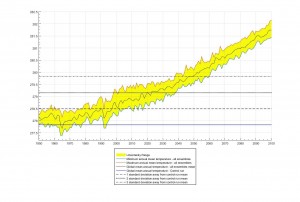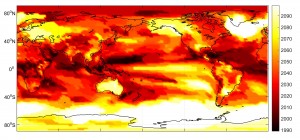Time of emergence of changes in climate variability in an Earth System Model
August 4, 2015
by Maxime Jullian
Part of the EPSRC Vacation Bursaries Scheme 2015
Student name: Maxime Jullian
Student degree course: BSc Oceanography
Year of study: 3rd Year (starting September 2015)
Supervisor: Dr Claudie Beaulieu
Vacation Bursary Research project title: “Time of emergence of changes in climate variability in an Earth System Model”.
Tell us a bit about you and your chosen research field:
I am an Oceanography student who is looking to specialise, during my university studies, in Physical Oceanography and Atmospheric sciences, looking at future changes in climate variability in an Earth System Model. And that is exactly the research field that I have tried to get involved with this summer 2015. Luckily I have found Dr Claudie Beaulieu, expert in climate statistics, to supervise me throughout this project. This research area is all new to me and technically challenging, using UNIX and MATLAB programming -which I am learning at the same time through Coursera online courses.
Figure 1: Graph of global annual mean temperature from 1950-2100 using an ensemble of 30 members of the GFDL-ESM2M model under a business-as-usual scenario compared with mean and standard deviation of the control run to estimate the time of emergence (timing at which the global annual mean temperature exceeds the control run standard deviation boundaries. Time of emergence (ToE) for 1 sigma = 1996, ToE for 2 sigma = 2025, ToE for 3 sigma = 2047.
Figure 2: Map showing past and future Time of Emergence from 1950-2100 worldwide for Ensemble member 1 under a Business-as-usual scenario. In this case the ToE is defined when the mean annual temperature at a location permanently exceeds a range of 2 standard deviation away from the control run mean annual temperature at that location. Areas in white shows regions where time of emergence doesn’t happen within 1950-2100.
Tell us about your specific research project:
The Project entitled “Time of emergence of changes in climate variability in an Earth System Model” aims to investigate the presence and timing of departure of changes in mean and variability in temperature and precipitation in future climate projections, through statistical approaches and MATLAB programming.
Using metrics from Industrial Statistical Quality Control, I am looking to determine the time of emergence of changes in the climate mean and variability, i.e the time at which the system goes beyond boundaries of natural variability and is deemed “out-of-control”. The natural variability is obtained from a model run unaffected by anthropogenic forcing.
I am using an ensemble of model projections of monthly temperature and precipitation from the Geophysical Fluid Dynamics Laboratory Earth System Model (GFDL-ESM2M) for the period 1950-2100 under a business-as-usual scenario.
This project hopes to fill a gap in the literature on climate change, which currently underestimates the possible impacts of changes in climate variability, including human and ecosystem vulnerability, food and water security, epidemic outbreaks, and national security through population shifts, heightened competition for natural resources and geopolitical instability.
If this area of research interests you, consider reading the following articles:
- “Perception of climate change”, Hansen et al., 2013. (http://www.pnas.org/content/109/37/E2415.full.pdf+html)
- “The projected timing of climate departure from recent variability”, Mora et al., 2003. (http://www.nature.com/nature/journal/v502/n7470/full/nature12540.html)
- “Climate variability and vulnerability to climate change: a review”, Thornton et al., 2014. (http://onlinelibrary.wiley.com/doi/10.1111/gcb.12581/pdf)
Describe any future plans regarding on-going study/postgraduate research connected to your Vacation Bursary project:
I will carry on with this research project beyond the EPSRC bursary and to my third-year independent research project where I intend to push the study further and achieve a substantial piece of research, as well as becoming fluent with MATLAB programming and Earth System Models.
Following my BSc Oceanography degree at the University of Southampton, I am strongly considering a Master’s degree in Environmental Technology with a specialisation in Water Resources Management at Imperial College London. I am hoping to make a career in water security worldwide, anticipating water shortages, droughts, and crop yields with regards to climate changes in variability, as well as studying water quality, global health and the spread of water-borne epidemics.
The EPSRC Vacation Bursary Award is a huge stepping stone to a career in the field and an opportunity to work with world-leading experts as well as developing independent research skills.
LINKEDIN Profile: Maxime Jullian
Categories: Blog. Tags: Blog, claudie beaulieu, earth system model, epsrc, idr, interdisciplinary, interdisciplinary research, Maxime Jullian, University of Southampton, USRG, vacation bursaries, and vacation bursary.



